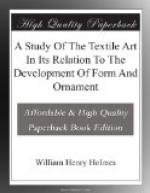Modifications of a decidedly esthetic character are generally suggested to the primitive mind by some functional, constructive, or accidental feature which may with ease be turned in the new direction. In the vessel presented in Fig. 289—the work of Alaskan Indians—the margin is varied by altering the relations of the three marginal turns of the coil, producing a scalloped effect. This is without reference to use, is uncalled for in construction, and hence is, in all probability, the direct result of esthetic tendencies. Other and much more elaborate examples may be found in the basketry of almost all countries.
[Illustration: Fig. 289. Vessel with esthetic characters of form. Work of the Yakama—1/4.]
In the pursuit of this class of enrichment there is occasionally noticeable a tendency to overload the subject with extraneous details. This is not apt to occur, however, in the indigenous practice of an art, but comes more frequently from a loss of equilibrium or balance in motives or desires, caused by untoward exotic influence. When, through suggestions derived from contact with civilized art, the savage undertakes to secure all the grace and complexity observed in the works of more cultured peoples, he does so at the expense of construction and adaptability to use. An example of such work is presented in Fig. 290, a weak, useless, and wholly vicious piece of basketry. Other equally meretricious pieces represent goblets, bottles, and tea pots. They are the work of the Indians of the northwest coast and are executed in the neatest possible manner, bearing evidence of the existence of cultivated taste.
[Illustration: Fig. 290. Basket made under foreign influence, construction and use being sacrificed to fancied beauty—1/3.]
It appears from the preceding analyses that form in this art is not sufficiently sensitive to receive impressions readily from the delicate touch of esthetic fingers; besides, there are peculiar difficulties in the way of detecting traces of the presence and supervision of taste. The inherent morphologic forces of the art are strong and stubborn and tend to produce the precise classes of results that we, at this stage of culture, are inclined to attribute to esthetic influence. If, in the making of a vessel, the demands of use are fully satisfied, if construction is perfect of its kind, if materials are uniformly suitable, and if models are not absolutely bad, it follows that the result must necessarily possess in a high degree those very attributes that all agree are pleasing to the eye.




